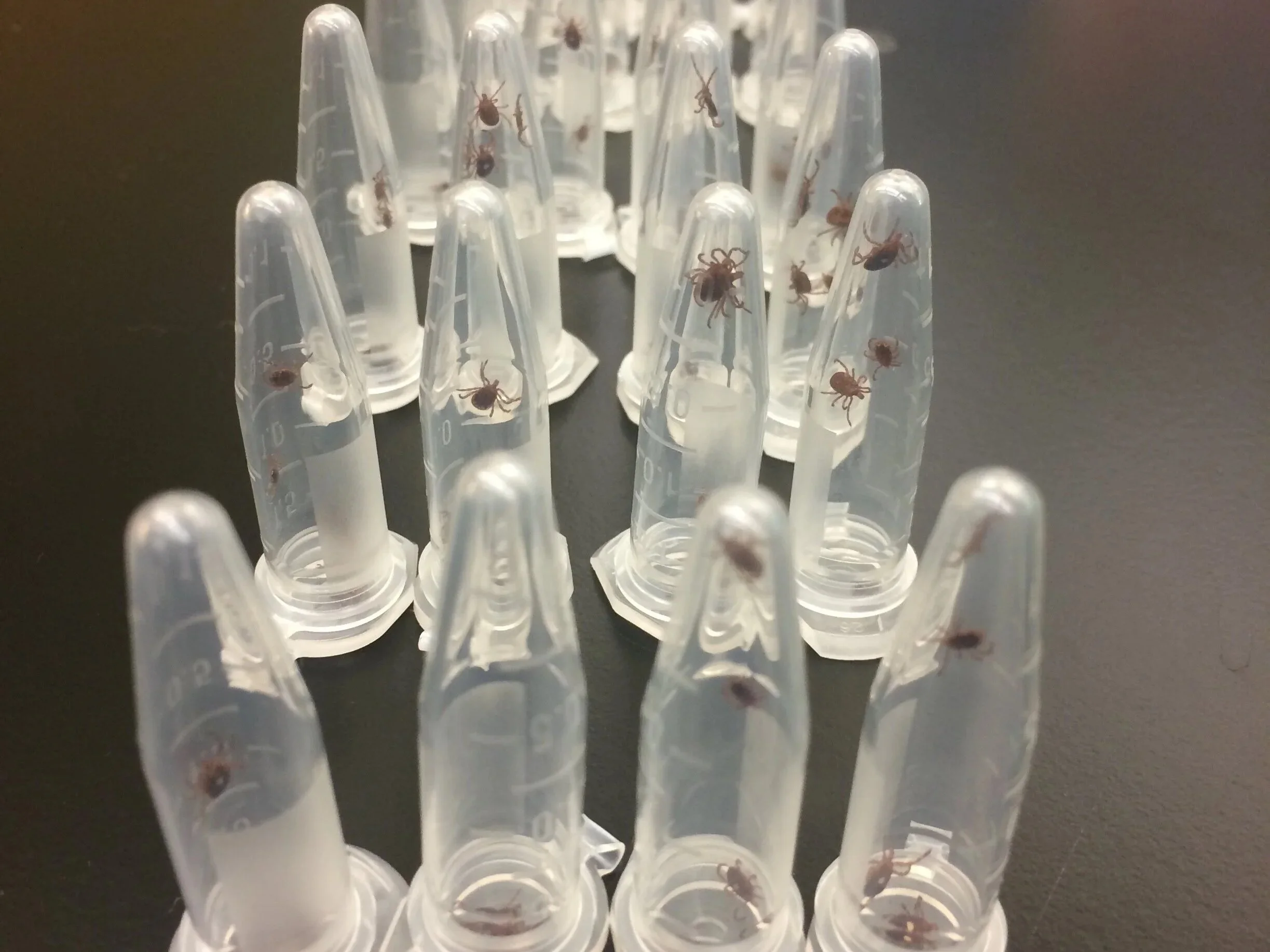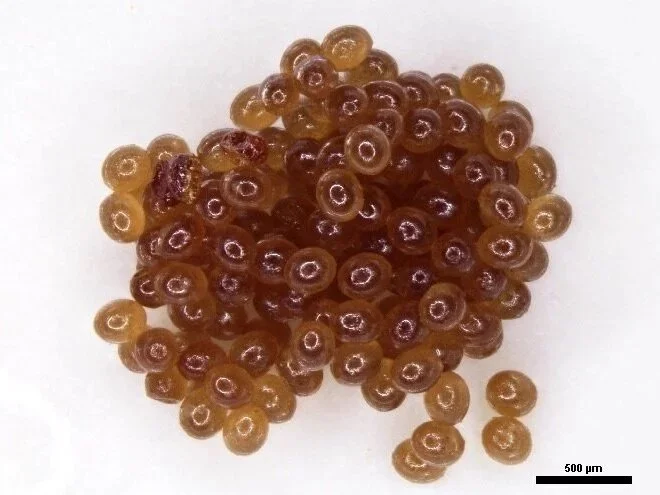We study how human impacts on the environment (for example, land management and urbanization) affect disease risk for humans and wildlife and biodiversity conservation. We use field experiments, ecological theory, and mathematical modeling to address basic and applied research questions aimed at improving human, animal, and ecosystem health. Our work is highly collaborative and interdisciplinary; we work with virologists, microbiologists, veterinarians, computer scientists, social scientists, land managers, urban planners, and more!
Tick-borne disease ecology
In the US, ticks cause the majority of vector-borne diseases, and the incidence of tick-borne diseases is rising. Tick-borne diseases are the result of complex ecological interactions among ticks, animals hosts, disease-causing pathogens, and the environment. We work on a number of local, regional, and national studies on tick-borne disease ecology, and we regularly share data with land managers and public health agency partners to improve awareness and surveillance.
Some examples of our published work:
Bamunuarachchi, G., Najera, F., Aziati, I. D., Palmer, J. L., Biro, E. G., Wang, D., Deem, S. L., Boon, A. C. M., & Adalsteinsson, S. A. (2025). Serosurveillance identifies Bourbon Virus-neutralizing antibodies in bobcats, coyotes, and red foxes in Missouri. Vector-Borne and Zoonotic Diseases, 25(4), 287–294. https://doi.org/10.1089/vbz.2024.0076
McFarland, D., Jr.*, Wallace, K.*, Blocher, B. H., Nicholson, W. L., Soares, L., & Adalsteinsson, S. A. (2025). High burdens of Ixodes scapularis ticks and surveillance for Babesia spp. in Carolina Wrens (Thryothorus ludovicianus) in Missouri, USA. Journal of Medical Entomology, 62(5), 1353–1357. https://doi.org/10.1093/jme/tjaf076
Aziati, I.D., McFarland, D., Jr.*, Antia, A., Joshi, A., Aviles Gamboa, A., Lee, P., Harastani, H., Wang, D., Adalsteinsson, S.A., Boon, A.C.M.. (2023) Prevalence of Bourbon and Heartland viruses in field collected ticks at an environmental research station in St. Louis County, Missouri, USA. Ticks and Tick-borne Diseases 14(1): 102080. https://doi.org/10.1016/j.ttbdis.2022.102080
Adalsteinsson, S.A., Shriver, W.G., Hojgaard, A., Bowman, J.L., Brisson, D., D’Amico, V., and J.J. Buler (2018) Multiflora rose invasion amplifies prevalence of Lyme disease pathogen, but not necessarily Lyme disease risk. Parasites & Vectors 11(1): 54. https://doi.org/10.1186/s13071-018-2623-0
Van Horn, T.R.*, Adalsteinsson, S.A., Westby, K.M., Biro, E., Myers, J.A., Spasojevic, M.J., Walton, M., and K.A. Medley (2018) Landscape physiognomy influences abundance of the lone star tick, Amblyomma americanum (Ixodida: Ixodidae), in Ozark Forests. Journal of Medical Entomology, 55(4): 982-988. https://doi.org/10.1093/jme/tjy038
Adalsteinsson, S.A., D’Amico, V., Shriver, W.G., Brisson, D., and J.J. Buler (2016) Scale-dependent effects of nonnative plant invasion on host-seeking tick abundance. Ecosphere 7(3): e01317. https://doi.org/10.1002/ecs2.1317
field-collected lone star tick (Amblyomma americanum) adults, credit: leslie sterling
engorged tick on the head of a Carolina wren (Thryothorus ludovicianus)
part of a lone star tick (A. americanum) egg mass
Urban wildlife ecology and conservation
Urban areas are the fastest-growing habitat type on the planet, and they present many unique features and challenges for wildlife populations. Understanding how urban landscape features affect different wildlife species is crucial to conserve wildlife and to maintain equitable access to nature while minimizing human-wildlife conflict. We study a variety of mammal, bird, and disease-vector arthropod species along urbanization gradients.
Some examples of our published work:
Anthonysamy, W. J. B., Biro, E. G., Adalsteinsson, S. A., Fidino, M., Moylan, M. A., & Zahrai, L. M. (2025). Urban intensity predicts eastern gray squirrel (Sciurus carolinensis) and fox squirrel (Sciurus niger) occupancy and detection in St. Louis green spaces. Journal of Urban Ecology, 11(1), juaf005. https://doi.org/10.1093/jue/juaf005
Murray, M.H., Surasinghe, T., Gelmi-Candusso, T., Sander, H.A., Lilly, M., Rivera, K., Fidino, M., Adalsteinsson, S.A., Flores, A., Diuk-Wasser, M.A., Magle, S. (2025) Multicity research networks are needed to address global One Health challenges, BioScience, biaf106, https://doi.org/10.1093/biosci/biaf106
Westby, K.M., Adalsteinsson, S.A. Biro, E.G., Beckermann, A.J.*, Medley, K.A. (2021) Aedes albopictus populations and larval habitat characteristics across the landscape: significant differences exist between urban and rural land use types. Insects 12(3): 196. https://doi.org/10.3390/insects12030196
Adalsteinsson, S.A., Buler, J.J., Bowman, J.L., D’Amico, V., Ladin, Z., and W.G. Shriver (2018) Post-independence mortality of juveniles is driven by anthropogenic hazards for two passerines in an urban landscape. Journal of Avian Biology: e01555. https://doi.org/10.1111/jav.01555
Ladin, Z.S., Van Nieuland, S.V., Adalsteinsson, S.A., D’Amico, V., Bowman, J.L., Buler, J.J., Baetens, J.M., De Baets, B., and W.G. Shriver (2018) Differential post-fledging habitat use of Nearctic-Neotropical migratory birds within an urbanized landscape. Movement Ecology 6(1): 17. https://doi.org/10.1186/s40462-018-0132-6
A big brown bat (Eptesicus fuscus) roosting on a building
path of a radio-tracked fledgling wood thrush (Hylocichla mustelina) between forest patches in newark, delaware
Fledgling wood thrush with radiotransmitter antenna visible (Credit: Matthias Sirch)







